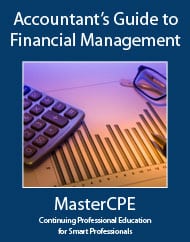Course Information
Accountant’s Guide to Financial Management
Course Information
| Title: | Accountant’s Guide to Financial Management |
|---|---|
| Category: | Finance |
| Field of Study: | Finance |
| Course Code: | M277 |
| CPE Credits: | 15.0 |
| Price: | 77.95 |
Description
Description:
This course is designed for accountants who must have financial knowledge but has not had formal training in finance. Topics include: The Sarbanes-Oxley Act financial reporting requirements, uses and analysis of financial statements, financial forecasting and cash budgeting, risk and return, valuation of stocks and bonds, time value of money, investing and financing, leverage, optimal capital structure, portfolio selection, management of financial resources, and international finance. The goals of the course are fourfold: 1. It provides an understanding and working knowledge of the fundamentals of financial decision making and strategy that can be put to practical application in day-to-day jobs of accountants and managers. 2. It also concentrates on providing a working vocabulary for communication. 3. It uses examples and illustrations, with emphasis on the practical application of financial concepts, tools, and methodology. 4. It also includes checklists, guidelines, rules of thumb, diagrams, graphs, and tab
Delivery Method: Online Interactive Self Study
Level: Overview
Prerequisites: None
Advanced Preparation: None
Course Details
Category: Finance
Field of Study: Finance
Passing Score: 70%
Technical Details: Finance is a technical subject.
For More Detail:
If you are unable to view PDF then right click the mouse and click save link as
Objectives
Objectives:
Chapter 1: An Overview of Financial Management 1. Identify the objectives of managerial finance. 2. Distinguish between profit maximization and stockholder wealth maximization. 3. Recognize factors that affect the value of a firm. 4. Recognize the role of financial managers. 5. Recognize the various legal forms of business organization.
For More Objectives:
If you are unable to view PDF then right click the mouse and click save link as
Profession
NASBA: Yes
QAS: Yes
CPA: Suitable for all CPAs
IRS: No IRS credit for Enrolled Agents.
Profession Identifiers: CPA

